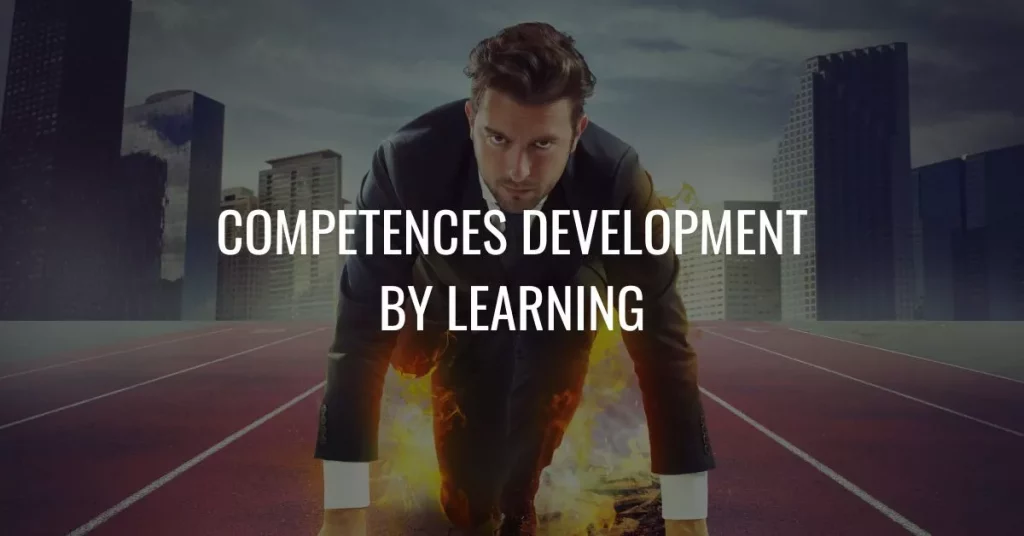Competences Development By Learning!
The development of competencies requires a positive attitude towards learning: if a person only follows the inclination of affective motivation and does not want to change, he will not be able to acquire a new competence because he will be unable to experience the benefits that would be obtained from following his rational motivation.
Although from the outside we can try to encourage others to cultivate an attitude that favors improvement, this attitude is part of each individual’s freedom and cannot be imposed.

Awareness of the causes of attitude
The most delicate part of the coach’s work. To achieve a change of attitude in an individual, the coach must first understand him well and be aware of the causes of his attitude before he can act on them. It would be a mistake to try to force a change of attitude without looking at its causes, a lasting solution to the problem can only be obtained by acting on the causes. There are two types of causes that influence the attitude in very different ways: self-esteem and character.
Self-esteem:
Self-esteem, or self-concept, is the interpretation that the individual has of himself: what he is worth, what he is valued for, and what he is capable of doing. This interpretation is created in the intelligence, often unconsciously, from the input accumulated by the individual both via information received and via experience.
Self-esteem can have many layers, some of the more universal (for example, considering oneself to be better than others because one comes from a particular country) and others more contextual (for example, considering oneself to be an expert in one sport but not in others). Through self-esteem, intelligence influences the will. If we feel capable of doing something that will be highly valued by others and which is also expected from us by others because of our experience, our position, our values, etc….
Our resolve will be strengthened to carry out this action, even though it may be difficult. However, if we think that it is beyond our possibilities to undertaking a certain action, or we think that it is not matched to our job or position, our resolve decreases and becomes weaker.
When the coach detects a lack of resolve due to low self-esteem, he must analyze whether or not this self-esteem is realistic. If it is not, he can provide data and opinions that help the person change his opinion about himself. Indeed, a worker’s attitudes – and, therefore, the competencies he develops – are very different depending on whether he considers himself a mere subordinate, an independent professional, or a member of a team.
In the first case, his attitude tends to be reactive, in the second, proactive, and in the third, cooperative. And with each attitude, specific competencies are developed (dependent talent, independent talent, and interdependent talent).
Self-esteem problem
Sometimes, the self-esteem problem arises not so much from the generic concept one has about oneself but the unjustified belief that one is not able to perform a specific task. In this case, it is called a self-efficacy problem.
The coach can help through at least five mechanisms:
The coach should treat self-esteem problems and help the employees through one or more of the following mechanisms.
- Attacking the reasons that lead the individual to believe that he cannot perform the task.
- Taking him through simpler challenges with a gradual increase in the level of difficulty (inclined plane).
- Showing him how other people do it.
- Assuring him of his (the coach’s) personal confidence that he can do it.
- And looking for ways to reduce the stress caused by that action.
In any case, it is important that the coach check that the belief really is unjustified. If the individual really is unable to carry out that activity, it may be harmful and even unfair to try to strengthen self-efficacy, since the experience of failure is highly unpleasant and, eventually, lowers personal self-esteem even further
Character:
The other possible cause of a “lack of will” for learning is character. Character is, to a certain extent, the style taken by an individual’s will as a consequence of the decisions he makes or does not make during his life.
In this sense, the character is an important part of the personality and is more or less stable, although it can change. The character can be educated, and it can also be “soured”. However, in the short term, it has stability that gives it predictiveness.
Thus, we can say that there are people with a stronger or weaker character, more emotional or more intellectual, more impassioned or more serene.” These differences are due to people’s different degrees of development along certain basic dimensions of character, which we call rationality, integrity, affectivity, and virtuality; Will acts through these dimensions in decision-making and, depending on their level of development; its action is strengthened or weakened.
This explains why the character has so much impact on the learning process.
How they will act on the development of competencies?
Read this article (Competences development)
When the cause of a negative attitude towards learning is a character, the problem is more difficult to resolve and requires a deeper personal improvement process than in the case of self-esteem. Basically, it is a problem of immaturity.
Maturity is the harmonious development of the dimensions of character. The immature person is unable to commit, is emotionally unstable, and readily falls into self-deception, often living in an unreal world fabricated by himself – sometimes unconsciously – to justify his behavior.
The immature person suffers the cruelest slavery: the incapacitation of the will, with the loss of the deepest freedom. The immature person loses control of himself and is at the mercy of his impulses, which can be readily manipulated from outside.
Consequently, “the attainment of emotional freedom – the positive integration of feelings and passions with an honest understanding of the world and oneself – is the goal pursued by any education of character”.
The coach’s action, in this case, is vital because the immature person has great difficulty in extricating himself from this state by himself. Educating the character consists of educating the virtue.
In fact, one author argues that “having character and being virtuous are now coincident expressions”. “Virtue is therefore a strengthening of the will, the positive yield of freedom. Thanks to virtue, one acquires a strength that previously one did not have and therefore, one can do things that, prior to that seemed impossible”.
There are four basic virtues in the education of character, one for each dimension. These virtues are the four classic or cardinal virtues (from “cardo”, hinge on which the other virtues rest): prudence, justice, temperance, and fortitude. They play an essential role in the development of any competence, particularly the most basic competencies which we call meta-competencies.

Patrick is a lifelong learner and personal development blogger whose work focuses on mindset shifts, emotional growth, and the hard-won lessons from real-life challenges.
Qualities: Relatable, honest, introspective, growth-oriented.
